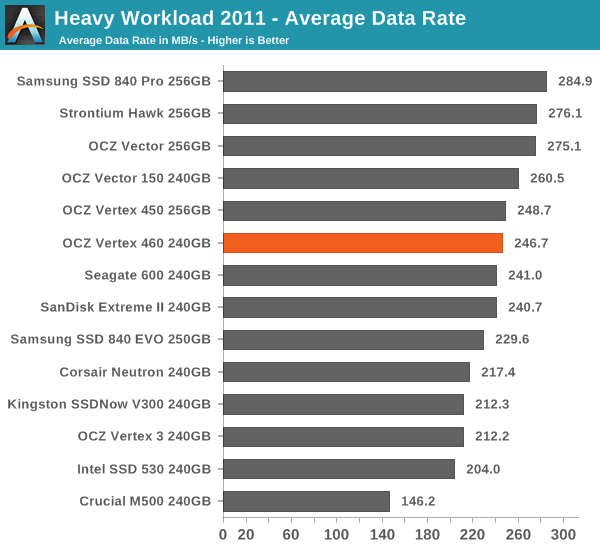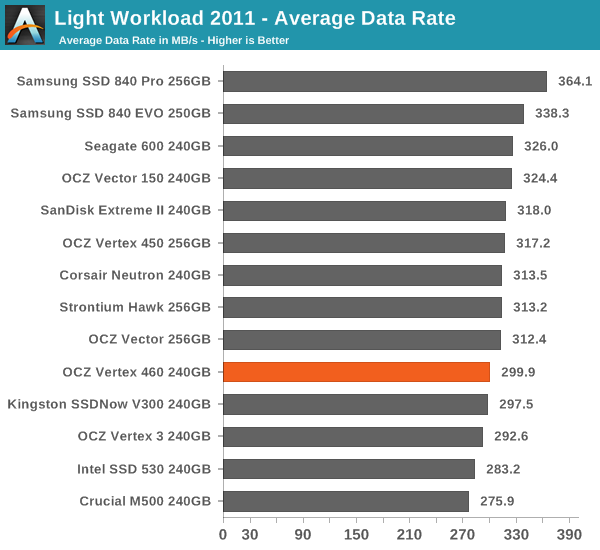OCZ Vertex 460 (240GB) Review
by Kristian Vättö on January 22, 2014 9:00 AM EST- Posted in
- Storage
- SSDs
- OCZ
- Indilinx
- Vertex 460
AnandTech Storage Bench 2011
Two years ago we introduced our AnandTech Storage Bench, a suite of benchmarks that took traces of real OS/application usage and played them back in a repeatable manner. Anand assembled the traces out of frustration with the majority of what we have today in terms of SSD benchmarks.
Although the AnandTech Storage Bench tests did a good job of characterizing SSD performance, they weren't stressful enough. All of the tests performed less than 10GB of reads/writes and typically involved only 4GB of writes specifically. That's not even enough exceed the spare area on most SSDs. Most canned SSD benchmarks don't even come close to writing a single gigabyte of data, but that doesn't mean that simply writing 4GB is acceptable.
Originally the benchmarks were kept short enough that they wouldn't be a burden to run (~30 minutes) but long enough that they were representative of what a power user might do with their system.
1) The MOASB, officially called AnandTech Storage Bench 2011 - Heavy Workload, mainly focuses on the times when your I/O activity is the highest. There is a lot of downloading and application installing that happens during the course of this test. Our thinking was that it's during application installs, file copies, downloading and multitasking with all of this that you can really notice performance differences between drives.
2) We tried to cover as many bases as possible with the software incorporated into this test. There's a lot of photo editing in Photoshop, HTML editing in Dreamweaver, web browsing, game playing/level loading (Starcraft II & WoW are both a part of the test) as well as general use stuff (application installing, virus scanning). We've included a large amount of email downloading, document creation and editing as well. To top it all off we even use Visual Studio 2008 to build Chromium during the test.
The test has 2,168,893 read operations and 1,783,447 write operations. The IO breakdown is as follows:
| AnandTech Storage Bench 2011 - Heavy Workload IO Breakdown | ||||
| IO Size | % of Total | |||
| 4KB | 28% | |||
| 16KB | 10% | |||
| 32KB | 10% | |||
| 64KB | 4% | |||
Only 42% of all operations are sequential, the rest range from pseudo to fully random (with most falling in the pseudo-random category). Average queue depth is 4.625 IOs, with 59% of operations taking place in an IO queue of 1.
AnandTech Storage Bench 2011 - Heavy Workload

The full results, including disk busy times and read/write separations, can be found in our Bench.
AnandTech Storage Bench 2011 - Light Workload
Our light workload actually has more write operations than read operations. The split is as follows: 372,630 reads and 459,709 writes. The relatively close read/write ratio does better mimic a typical light workload (although even lighter workloads would be far more read centric). There's lots of web browsing, photo editing (but with a greater focus on photo consumption), video playback as well as some application installs and gaming.
The I/O breakdown is similar to the heavy workload at small IOs, however you'll notice that there are far fewer large IO transfers. Interestingly, the 480GB drive actually comes out ahead in this case, suggesting it's more capable at light workloads.
| AnandTech Storage Bench 2011 - Light Workload IO Breakdown | ||||
| IO Size | % of Total | |||
| 4KB | 27% | |||
| 16KB | 8% | |||
| 32KB | 6% | |||
| 64KB | 5% | |||











69 Comments
View All Comments
dgingeri - Wednesday, January 22, 2014 - link
This thing has the same problem as my Vertex 4 drives. I'm not impressed. It essentially means that half the capacity is unusable due to the way the controller works.Guspaz - Wednesday, January 22, 2014 - link
Hrrm. Getting merged into Toshiba's SSD group is about the only thing that might have tempered my "never again" position on OCZ. By keeping them independent, they're doing nothing to convince me that they're going to change their ways. It's their own questionable decisions that got them into this mess (their reputation for poor reliability), sacrificing reliability at the alter of performance and shipping first.dgingeri - Wednesday, January 22, 2014 - link
You think the Toshiba name is good reliability? I have 224 enterprise hard drives that would say differently. Four years ago, I got 204 Fujitsu/Toshiba (just after Toshiba took over) 146GB 15k SAS drives. Over the course of the first three years, I replaced 165 of them, plus 19 of the replacements that came in as Toshiba branded drives with the same model number. After the warranty ended, I have had to replace the remaining ones by purchasing new ones. None of them are left now. All have been replaced with Seagate Saavios of the same size. They are worse than any desktop level hard drives I have dealt with in my career. I've only had one incident like it, and that was replacing Dell Optiplex motherboards with embedded TNT2-m64 chips back in 2000.Guspaz - Wednesday, January 22, 2014 - link
Seagate has rather questionable reliability themselves (see BackBlaze's recent study on this), but Toshiba's hard disk division is unrelated to their SSD division, so the reliability of one doesn't necessarily give any indication about the reliability of the other.dgingeri - Wednesday, January 22, 2014 - link
In the 2.5" enterprise hard drive market, Seagate has been top of the heap for a long time. They really do well in that arena. There aren't a whole lot of players in that arena, though. Only Seagate, Toshiba (formerly Fujitsu,) and Hitachi. Seagate's Saavio line happens to be the first line ever in 2.5" 10k or 15k drives.As far as desktop drives go, Seagate's desktop drives have had reliability problems for years, sure, but they aren't near as bad as Toshiba's desktop drives.
Dahak - Wednesday, January 22, 2014 - link
Wonder if ocz will use/can use toshiba's ssd team for addition support(firmware/validation)even though they are separate entitiesAlso found it funny that while reading this review I had ads for Crucial's SSD :)
MrSpadge - Wednesday, January 22, 2014 - link
Otherwise the aquisition wouldn't make much sense, would it? Keep them somewhat separate but use any synergetic benefits.Dahak - Wednesday, January 22, 2014 - link
I would think so too but the way it is worded in the article seems like they wontpiroroadkill - Wednesday, January 22, 2014 - link
Why don't you just review a rock or a potato? Because I doubt many people want to purchase OCZ products.toyotabedzrock - Wednesday, January 22, 2014 - link
It might be a good idea to not copy and paste the same explanation of the tests in every article.Just link to the information. It is just headache inducing that I have hunt for relevant information interleaved with the copy and pasted parts.